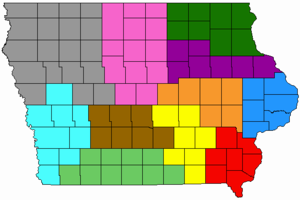
This is what Iowa’s 11(!) congressional districts looked like for the elections of 1882 and 1884. The 5th District is in orange. A mid-decade redraw after a special census in 1885 created a new map that would be used through the 1930 midterms. For more, see this page.
James Wilson, Traer’s most famous resident, served three nonconsecutive terms in Congress as a Republican. The first two were 1873-77, and that’s when he got the nickname “Tama Jim”, to distinguish himself from Iowa Sen. James Wilson of Jefferson. His third term came somewhat involuntarily. He attended the 5th Congressional District convention in Cedar Rapids in the summer of 1882 to show support for a friend. But as time dragged on and no candidate emerged, he was pressured to put his hat in the ring, and eventually agreed.
“But,” said the Traer Star-Clipper later, “he worked against such opposition as no candidate in Iowa ever had to combat. He believed that people had a right to decide whether a prohibitory clause should be engrafted into the constitution of the State, and he said so. This manly stand brought to the aid of his opponent the organized and powerful whisky element. As if this was not enough, he had to face shameful unfaithfulness in his own party, and the combined opposition succeeded in cutting his majority down to 23 votes. He was declared elected and took his seat.” (March 13, 1885)
Wilson’s opponent, Benjamin Frederick, refused to accept defeat and took his challenge to Congress. A subcommittee heard the challenge in June 1884 and then nothing happened — for the duration of the session. It was somewhat academic, as Democrats held an overwhelming majority in the House, but the situation remained officially unresolved.
Wilson was behind the creation of a law in 1884, and of course it was agriculture-related: “An act for the establishment of a Bureau of Animal Industry, to prevent the exportation of diseased cattle, and to provide means for the suppression and extirpation of pleuro-pneumonia and other contagious diseases among domestic animals.”*
